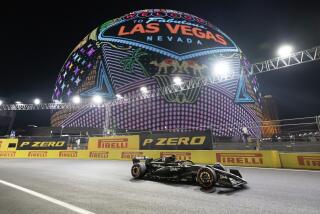Gamble in the Fast Lane
STUDIO CITY — Matrix Motors is chasing a dream at 200 mph. The tiny, 1-year-old firm is gambling that an 800-horsepower, turbo-charged race car will catapult it to international fame and fortune. The car, so far the company’s only asset, is registered for pre-qualifying events this weekend in the 24-hour Le Mans endurance race in France.
The race, one of the oldest and most prestigious motorsport competitions in the world, has long been the test of fire for global auto giants. But rarely has the race seen the likes of a car company like Matrix--a four-man firm operating out of a storefront on Cahuenga Boulevard.
Never has such a small company won the race. Matrix co-founders Lilo Benzieron and Wayne Hennebury plan to change all that.
“When we tell other people in this business what we intend to do, they look at us like we have three heads,” said Hennebury, 45. “We are unquestionably the David in the story of David and Goliath.”
But this David has more than a slingshot going for it. The Matrix MXP-1 combines the latest aerospace technology with old-fashioned grease-monkey mechanical work to create a four-wheeled demon capable of speeds in excess of 210 mph. Hennebury, a British immigrant, says success at Le Mans would bring Matrix closer to its ultimate goal--to start a full-fledged sports car company.
“We want to be recognized as a legitimate car company of the likes of Porsche and Ferrari,” Hennebury said.
Le Mans will be instrumental in Matrix’s success or failure, Benzieron and Hennebury say.
Since the international race began in 1906 on country roads with top speeds of less than 10 mph, the race has gained legendary proportions. The first 24-hour race (24 Heures Du Mans, in French) was on May 26, 1923, with 33 entrants. The race was won by a French team that covered 1,372.9 miles at an average speed of 57.21 mph.
Le Mans grew in international stature and prestige until 1955, when a car built by Mercedes-Benz left the track and burst into flames, spraying burning fuel and red hot metal into the surrounding spectators. The driver and more than 80 people were killed in the crash, the worst in racing history.
After calls to ban the race subsided, Le Mans’ fame grew in subsequent decades and the race now has become a global proving ground for auto manufacturers and their new technologies. More than 400 million spectators watch the televised race in more than 100 countries each year.
“It is a mythic race,” Le Mans spokesman and chief announcer Bruno Vandestick said. “And just as Le Mans is known all over the world, the teams that win have world impact.”
New technologies introduced at Le Mans also have wide-ranging ramifications, often trickling down to appear on passenger cars, Vandestick said. Examples he gave included radial tires, anti-fog headlights and turbo-charged engines.
The most technologically advanced cars at Le Mans compete in the elite Grand Tour Prototype category. The rest are modified street cars.
The MXP-1 is one of only 17 prototypes of the 85 cars trying to pre-qualify this weekend. These exotic cars are rarely mass-produced and are specifically created for racing. After the pre-qualifier race, only the fastest nine prototypes will be allowed to join the 48 cars competing in the 24-hour main event June 14.
In its pursuit of victory, Matrix has exploited advances in metallurgy by the aerospace industry to make a cooler, stronger, lighter transmission and engine, Benzieron and Hennebury say. Hennebury said cutbacks in the defense industry have made Southern California an ideal place to build their car company.
“There are now a lot of small companies with very highly skilled people and exacting machinery in this area,” Hennebury said. “Many of these have been involved in helping us with our car.”
But innovation in the auto industry costs money--lots of money, and Matrix’s budget is infinitesmal contrasted with the millions of dollars larger car companies pump into Le Mans every year. Sponsors have been known to shell out $2 million to have their decals pasted on big-name cars.
A few years ago, Jaguar’s total sports car racing budget was reportedly $25 million annually. This year Nissan, Dodge, Ford and BMW are all entering at least three cars each and 25 Porsches will try to pre-qualify this weekend.
“Eighty percent of this race is about money,” said Benzieron, a Frenchman who came to the United States 25 years ago. “The other 20% is luck.”
Money has been hard to come by for Matrix. The Dunlop Tire Co. was going to offer the company expensive racing tires for free. But the Kobe earthquake in Japan destroyed the plant that made the tires and the company reneged. At one time Warner Brothers indicated it would be interested in putting the Batman logo on the Matrix MXP-1 to promote its upcoming sequel. But studio executives decided to focus on domestic auto races, such as the Indianapolis 500, instead.
Having lured only a few sponsors, Benzieron and Hennebury have poured most of their personal finances into the company in the hope that the race will pay off after the pre-qualifying events. Also, Matrix has largely been a volunteer effort, with longtime friends working on the car over weekends and after-hours.
Benzieron, 42, says he has also taken out large loans and has borrowed money from his father-in-law, his father and every friend he could think of. “I don’t even know how we’re going to pay for the hotel in Le Mans. I’ve borrowed everything I could.”
Sitting in his sparsely furnished office, Benzieron laughs and points to his cousin. “He’s got one credit card left and I have my eye on it because we’re going to need it when we get to France.”
Benzieron is counting on a strong showing at the pre-qualifier to draw deep-pocketed sponsors for the race next month, hoping that economy-induced efficiencies will produce a better car.
“Anybody can build a tremendous race car for $2 million--if you can’t, you might as well pack it in,” Hennebury said. “But we have produced a tremendous car for half of that.”






